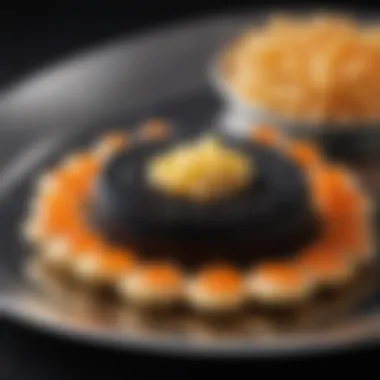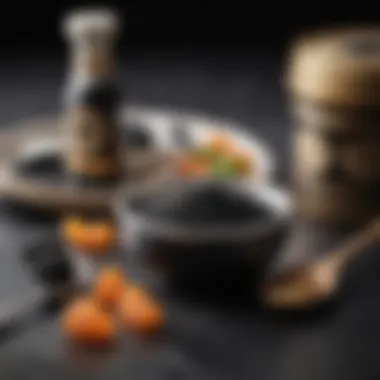Mastering the Art of Serving Caviar Elegantly


Intro
Caviar, often regarded as the epitome of luxury dining, has a long history steeped in tradition and elegance. This lavish delicacy hails from the eggs of sturgeon, and its allure is not just in its taste but also in its cultural significance throughout centuries. Serving caviar is not merely about presenting a dish; it involves an understanding of its origins, types, and the appropriate etiquette that comes along with it.
The intricate nuances of caviar can be daunting, especially for those entering the realm of fine dining. In this guide, we aim to break down these complexities and arm culinary enthusiasts and curious beginners with the knowledge they need. From the various types of caviar—each with its unique flavor profile and appearance—to the best practices for selection, storage, and presentation, we’ll cover it all.
Moreover, common misconceptions around caviar will be tackled head-on. It’s not just about the price tag; it’s about the experience. Pairing it intelligently with accompaniments enhances its rich flavor and elevates any gathering.
By the end of this detailed exploration, you will not only appreciate the beauty of caviar but also feel equipped to serve it with a certain je ne sais quoi—a touch of sophistication that befits this elegant food. So, let’s dive in and unravel the art of serving caviar, turning any occasion into a memorable experience.
Foreword to Caviar
Caviar is not just a food; it’s a symbol of opulence and a culinary experience that speaks volumes about taste and tradition. The intricate world of caviar holds a significant place in both history and modern cuisine, making it essential to understand its roots and evolution. This section delves into the importance of caviar, providing a solid foundation for appreciating its unique qualities and the reasons why one should savor it with mindfulness and reverence.
When discussing caviar, one must not overlook its allure and the finesse involved in its serving. The cultivation of caviar and its various types can influence not just the flavor profile but also how it is enjoyed. Knowing the different grades and styles of caviar adds depth to the overall dining experience, ensuring that one selects a type that suits the occasion. The elegance in how caviar is presented can elevate even a simple gathering into a lavish event, lending sophistication and flair.
Historical Overview
Caviar’s rich history stretches back centuries, intertwining with the cultures of various nations. Originally, caviar was consumed by ancient Persians, a delicacy favored by their aristocracy. The roe from sturgeon was so respected that it was often gifted to kings. By the 19th century, Russia became associated with caviar production, particularly with the famed Caspian Sea sturgeon species. The Russians innovated methods for preserving and serving caviar, establishing it as a luxurious staple at banquets.
In the early 20th century, caviar started to cross borders, appearing on tables in the Western world. It was a delicacy for the elite, often gracing the menus of high-end restaurants. The allure of caviar hasn’t waned; rather, it has evolved. Today, it is accessible to a growing number of connoisseurs, sparking interest in both traditional and contemporary culinary practices.
"Caviar not only reflects a nation’s culinary tradition but also showcases the artistry in food preservation and presentation."
Caviar in Modern Cuisine
Fast forward to modern times, caviar has found its place within diverse culinary contexts. While it’s still celebrated in fine dining, chefs globally have started experimenting with caviar in innovative ways. For instance, some pair it with unexpected flavors—like Asian influences in sushi, where it complements tuna, or Mediterranean dishes utilizing citrus to enhance its briny flavors.
The versatility of caviar allows it to mingle with various textures and tastes, inviting food lovers to explore beyond traditional pairings. From tasting platters alongside artisan bread to garnishing a gourmet dish, its presence can change the entire profile of a meal.
Here are some notable trends in caviar consumption today:
- Fusion Cooking: Combining techniques and ingredients from diverse cuisines.
- Sustainability: As environmental awareness rises, sustainable farming methods for caviar are gaining traction.
- Accessibility: Introduction of different price points makes caviar more approachable for everyday enjoyment.
Caviar stands not only as a food choice; it champions the art of gastronomic exploration, pushing the boundaries of flavor and tradition in the contemporary culinary scene. Understanding its historical significance and modern iterations prepares enthusiasts to appreciate caviar’s multifaceted roles.
Understanding Different Types of Caviar
Understanding the different types of caviar is not just about recognizing the nuances in flavor and texture but also about appreciating the heritage and the traditions that surround this delicacy. Different caviars have distinct characteristics influenced by the species of fish, their habitat, and the methods of production. This section explores the major types of caviar, providing insights that will deepen your appreciation for this luxurious treat and guide you in making informed selections when serving or purchasing caviar.
Beluga Caviar
Beluga caviar, harvested from the Beluga sturgeon, is often regarded as the most prestigious type available. Known for its large, soft pearls, the flavor is almost creamy, with a delicate, buttery finish. Beluga caviar also boasts a melony color, which ranges from silver-gray to dark slate. These pearls are prized not only for their taste but also for their rarity. Due to overfishing and environmental issues, Beluga sturgeon are considered endangered, which makes this caviar both a delicacy and a responsibility. When serving, remember that the best way to enjoy Beluga is with minimal accompaniments, allowing its richness to shine through.
Osetra Caviar
Osetra caviar comes from the Osetra sturgeon and offers a bit more variation in flavor. Its pearls can range from medium to large and are often a beautiful golden-brown or dark gray. The taste is notably more robust compared to Beluga, with a slightly nutty quality that some describe as reminiscent of toasted hazelnuts. Serving Osetra caviar allows for some playfulness with pairings; it can hold its own against lighter options like toast points or even boiled potatoes, giving guests a delightful tongue dance of flavors.
Sevruga Caviar
When you think of a bold burst of flavor, Sevruga caviar is your go-to. Sourced from the Sevruga sturgeon, these tiny, dark pearls pack a punch in terms of taste. Often smaller than both Beluga and Osetra, the flavor profile can be intense, savory, and briny, perfect for those who relish a stronger caviar. Due to their more accessible price point, Sevruga caviar presents an excellent opportunity for those wanting to explore caviar without diving straight into the most expensive types.
Farmed vs. Wild Caviar
One important distinction in the caviar world is between farmed and wild caviar. Wild caviar comes from fish caught in their natural habitats, while farmed caviar is produced through aquaculture.
- Wild Caviar: This type is often seen as more authentic, with unique flavors tied closely to the region of catch, but it’s also subject to strict regulations and declining stocks.
- Farmed Caviar: Offers a more consistent quality and is often more sustainable, as it helps reduce pressure on wild populations.
Determining which to serve involves considering flavor preferences and ethical practices; understanding this distinction is key to a responsible and satisfying caviar experience.


Choosing the Right Caviar
Choosing the right caviar is like selecting the perfect wine to complement your meal. The quality, flavor profile, and character of caviar can vary greatly, which makes this choice a crucial aspect for any connoisseur or casual enjoyer alike. Different types of caviar come with unique taste experiences and textures that can elevate a dish or a gathering. Understanding the factors that influence your choice not only enhances your dining experience but also reflects your knowledge and appreciation of this delicacy.
Evaluating Quality
When it comes to caviar, quality reigns supreme. But how do you sift through the options available?
- Color: High-quality caviar tends to exhibit a vibrant appearance. For instance, Beluga caviar ranges from silver-gray to dark black, while Osetra may be golden brown. If the color looks dull or outdated, it’s likely not the best pick.
- Texture: The eggs should be firm yet delicate, popping in your mouth. Quality caviar feels like satin between your fingers if you’re inclined to touch it. A mushy or inconsistent texture often signifies poor storage or handling.
- Aroma: Fresh caviar has a subtle marine scent, reminiscent of a fresh sea breeze. If the aroma is fishy or overly strong, steer clear, as this indicates spoilage.
- Taste: True connoisseurs often suggest a small taste before making a decision. Quality caviar offers a complex, briny flavor that dances on the palate without overwhelming the senses. Clean and crisp, the taste should leave a clean finish.
"Quality caviar is not just about price; it's about the overall experience. Engage all your senses when making your choice."
Where to Purchase
Knowing where to buy caviar can be just as critical as selecting the right type. Not all caviar merchants have the same standards of quality. Here's where to focus your attention:
- Specialty Food Stores: Seek out local gourmet shops or specialty stores that specialize in fish or artisan foods. These places often have knowledgeable staff who can guide you.
- Online Retailers: Websites like Petrossian and The Caviar Co. offer direct-to-consumer options, sometimes even fresher than what you’d find in physical stores. Just ensure they provide clear details about sourcing and storage.
- Fish Markets: Some brick-and-mortar fish markets also carry caviar. For instance, a reputable market might source their caviar from sustainable farms, giving you peace of mind about quality.
- Catering Services: If you're planning an event, reaching out to a catering company known for high-end offerings can save you the hassle. They can provide both caviar and the expertise in serving it.
Before making a purchase, always ask questions. Inquire about the source, handling, and expiration date, as these factors can greatly influence your experience with caviar.
Storage and Handling of Caviar
Storing and handling caviar properly is not merely an act of caution; it is a necessity that preserves the delicate qualities of this luxurious delicacy. Caviar is susceptible to a host of factors—temperature fluctuations, exposure to air, and even light can drastically alter its flavor and texture. By understanding the nuances of caviar storage, you ensure not just its longevity, but also a superior tasting experience. It’s much like keeping a fine wine; the right conditions can elevate the experience, while improper ones can ruin it entirely.
Temperature Control
The temperature at which caviar is stored plays a crucial role in maintaining its quality. Ideally, caviar should be kept at a consistent temperature between 28°F and 32°F (-2°C to 0°C). A dedicated refrigerator or a specialized caviar fridge is recommended for this purpose. When caviar is exposed to warmer temperatures, it can spoil quickly, leading to a less than desirable taste and texture.
To ensure optimal conditions:
- Use a refrigerator with a stable temperature: Fluctuating temperatures can be detrimental. Check for temperature consistency regularly.
- Avoid storing near the door: Frequent opening can cause temperature swings that may harm the caviar.
- Wrap it well: Keep the caviar in its original packaging and place it in an airtight container to protect it from exposure to air.
"A well-stored caviar retains its fine balance of flavor, ensuring each bite is an exquisite experience."
Best Practices for Preservation
Preserving caviar isn’t just about temperature; it encompasses various practices that safeguard its unique attributes. Here are some strategies to keep your caviar in top-notch condition:
- Minimize air exposure: Caviar thrives in low-oxygen environments. If you cannot consume the entire jar, consider vacuum sealing or transferring to a smaller container to limit air contact.
- Avoid freezing: While freezing might seem like an option for preservation, it can alter the texture of caviar irreparably. Use chilled methods instead.
- Consume promptly: Once opened, caviar should be enjoyed within 48 hours. Each moment beyond that diminishes its quality.
A well-preserved caviar delivers its complex flavors, flirting with the taste buds in a delightful dance. Taking the time to understand how to store and handle caviar will not only enhance your experience but will also impress your guests with its premium qualities.
The Art of Serving Caviar
In the world of culinary delights, few things evoke the same luxurious allure as caviar. Serving caviar isn't merely about dishing out a treat; it's a form of art that speaks volumes about sophistication and attention to detail. Understanding the intricacies involved in this endeavor enriches not just the dining experience but also the appreciation of the delicacy itself. By mastering the techniques and tools of serving caviar, you elevate a simple meal into a grand occasion—one that celebrates flavors, culture, and history.
Presenting caviar appropriately allows you to honor its rich legacy while enhancing the sensory experience it offers. Each detail, from the selection of serving tools to the aesthetics of the presentation, carries weight in creating a memorable encounter. A misstep might lead to diminished flavors or even offend an experienced palate. Thus, learning the art of serving caviar is essential for both connoisseurs and novices.
Essential Serving Tools
To serve caviar like a pro, you need to gather a specific set of tools that not only facilitate the service but also enhance the caviar's flavors. Here are the indispensable tools:
- Mother-of-pearl Spoon: This is perhaps the most vital tool in your caviar arsenal. A mother-of-pearl spoon is preferred because metal utensils can react with the delicate roe, altering its taste. The smooth, non-reactive surface allows for a pure tasting experience.
- Chilled Serving Dish: Keeping caviar at optimal temperature is key. A glass or porcelain dish with ice ensures that the caviar remains fresh and flavorful throughout your serving time.
- Small Bowls or Cups: For different types or flavors of caviar, using small bowls helps keep them segregated yet accessible. It also adds a touch of elegance and sophistication.
- Blinis and Bread Knife: If you're opting to serve caviar with accompaniments like blinis or bread, a sharp knife is necessary to avoid squishing the bread and losing its texture.
- Ice Bucket: If you're serving a larger gathering, an ice bucket can keep multiple servings of caviar cold, making it a practical addition to your serving setup.
By preparing these essential tools ahead of time, you ensure a smoother serving process that showcases the caviar beautifully.
Presentation Techniques
Presentation is everything when it comes to serving caviar. The way caviar is displayed can influence its perception and enjoyment, elevating it from a dish to an experience. Here are several effective techniques:


- Layering for Impact: Start with a bed of crushed ice on your serving platter and place your small bowls of caviar atop it. This not only keeps the caviar chilled but also adds a visual layer that catches the eye.
- Color Harmony: Choose serveware that complements the color of the caviar. For instance, dark dishes can make golden or pale caviar pop, while lighter dishes enhance darker varieties.
- Minimalist Approach: Sometimes, less is more. A simple arrangement with one type of caviar presented elegantly can make a striking impression. Let the caviar take center stage.
- Garnish Mindfully: If you're including garnishes, keep them subtle. A few capers or microgreens can enhance the visual aesthetic without overshadowing the delicate characteristics of the caviar.
- Plating with Thought: Use small pipettes filled with lemon juice or other creams as a miniature garnish when serving. These can be placed alongside the caviar as a playful yet sophisticated touch that invites your guests to experiment with flavors.
"The first bite should be a visual feast; only then do the flavors perform their dance."
These techniques are bound to not just impress your guests but also create an experience that resonates with the essence of caviar—a delicacy steeped in tradition and decadence.
Caviar Pairings
Pairing caviar with the right accompaniments is key to enhancing its luxurious taste and elevating the entire dining experience. Understanding the subtleties of flavor is crucial as caviar's distinctive nature can be easily overshadowed by stronger tastes. Therefore, crafting thoughtful pairings that celebrate the umami and briny notes of caviar will significantly enrich the enjoyment.
Bread and Blinis
When it comes to serving caviar, bread and blinis stand as the classic foundations for presenting this delicacy. Thin pancakes, known as blinis, are particularly favored for their light texture and ability to absorb flavors without overpowering the caviar itself. Traditionally, buckwheat blinis are a popular choice, lending a subtle nutty flavor that pairs wonderfully with both Beluga and Osetra caviar.
For those who prefer a simpler route, lightly toasted baguette slices or pumpernickel can serve as an excellent base. The crusty exterior of the bread adds a satisfying crunch while the airy interior provides a canvas for the caviar. Just remember to keep the bread warm but not hot; this ensures a perfect contrast to the cold caviar, making each bite a delight.
Condiments and Garnishes
While caviar shines brilliantly on its own, adding complimentary condiments and garnishes can provide layers of flavor that enhance the tasting experience.
Some popular condiments include creme fraiche, which introduces a creamy richness and balances the salinity of caviar. Minced shallots or finely chopped red onions can add a zesty kick, while chives offer a fresh crunch that pairs well with the delicate caviar beads.
When considering garnishes, focus on those that won’t mask the caviar's unique taste. Elements such as hard-boiled eggs, thinly sliced radishes, or even edible flowers can provide an elegant touch.
"Caviar is often regarded as an art form itself, and the garnishes and accompaniments should be chosen with the same level of care."
Complementary Beverages
The right drink can complement caviar beautifully, ensuring that each sip and bite carries through the luxurious experience. Traditionally, champagne reigns supreme, with its effervescence cutting through the richness of the caviar. A crisp, dry brut often works best, as the acidity enhances the briny notes delicately.
Alternatively, vodka, especially when served ice-cold, can be a perfect match. Keep in mind that it should be sipped slowly, allowing the caviar to take center stage. Other options like dry white wines, particularly French Chablis or a light Sauvignon Blanc, can harmonize well with different types of caviar. When selecting a beverage, consider the caviar type and the overall flavor profile you aim to achieve.
In summary, when serving caviar, thoughtful pairings are essential. Each element, from the bread to the beverages, should work in unison to elevate the entire dining experience, ensuring that the brilliance of caviar is allowed to shine.
Etiquette Surrounding Caviar
Embracing the nuances of caviar etiquette can elevate the experience from mere consumption to a true culinary celebration. The ritual surrounding caviar involves not only understanding how to serve and savor this delicacy but also being aware of the unspoken rules that govern its presentation and enjoyment. Proper etiquette ensures that the experience is respectful to the tradition of caviar and enhances the overall pleasure for all involved.
Dos and Don'ts
When it comes to enjoying caviar, there are certain guidelines that can help ensure you are making the most out of your indulgence. These dos and don’ts create a respectful environment and elevate both personal enjoyment and the experience of those around you.
Dos:
- Do serve caviar chilled: Always keep it on ice to retain its freshness and texture.
- Do use appropriate utensils: Stainless steel or mother-of-pearl spoons are ideal. Avoid metal spoons, as they can alter the taste.
- Do pair with complementary items: When serving, offer blinis or toast points and a selection of condiments that enhance the caviar without overshadowing its unique flavors.
- Do have a respectful portion size: Serving small amounts allows guests to savor without overindulgence.
Don'ts:
- Don’t rush the tasting: Appreciate each nuance, sip, and crunch. Caviar is a delicacy meant to be savored.
- Don’t mix too many flavors: Avoid overwhelming the caviar with too many garnishes. Less is often more in this case.
- Don’t let caviar get warm: Leaving it out can spoil the experience. Always have a cooling method in place when serving.
- Don’t forget to clarify etiquette with guests: If you're hosting, ensure your guests know the proper way to enjoy it.
"Eating caviar is not just about the taste; it's about the experience, the ambiance, and the respect for a tradition that spans centuries."
Cultural Considerations
Caviar carries a rich heritage across various cultures, reflected in how it is served and enjoyed. Understanding these cultural nuances can enrich the experience and demonstrate respect for the delicacy’s origins.
- United States: The American enjoyment of caviar is often more casual and is frequently paired with creative interpretations in modern cuisine. Here, you’ll find caviar on everything from potato chips to gourmet burgers.
- Russia: Traditionally, Russians have a deep respect for caviar, often serving with vodka as a way to enhance both flavors. It’s common to find caviar paired with thick slices of buttered bread, harkening back to its regal roots.
- France: The French have a flair for elegance and presentation. Caviar is often served with finesse at upscale dining establishments, accompanied by champagne or white wine. The French approach can include elaborate garnishes, though still maintaining the caviar’s refined flavor.
- Japan: While not a traditional part of Japanese cuisine, caviar can be found in fusion dishes, symbolizing a blend of cultures and flavors.
Understanding these cultural differences enables both food lovers and hosts to approach the serving of caviar with a broader mindset, bridging gaps and embracing culinary diversity. When one absorbs and respects these subtleties, it only enriches the experience shared around the table.


Common Misconceptions About Caviar
Caviar is often shrouded in an air of mystery and pretense, leading to several misperceptions that can cloud the experience of enjoying this delicacy. Understanding these misconceptions is crucial, as it enables enthusiasts and novices alike to appreciate caviar’s true value and its place within culinary tradition. By dispelling myths surrounding caviar, people can approach this delicacy with a more informed perspective and savor it in a way that aligns with its rich heritage.
Price vs. Quality
When it comes to caviar, many people assume that a higher price tag automatically indicates superior quality. While it’s true that price can be an indicator of artisanal production methods and the rarity of certain caviar types, it is not the sole determinant of quality. Consider the following points:
- Different Varieties: Not all caviar is created equal. For instance, Beluga is often more expensive due to its scarcity, while Osetra might offer a delightful taste at a lower cost.
- Production Methods: Farmed caviar can sometimes be on par with or even surpass wild caviar in quality and taste, contrary to popular belief.
- Taste Preference: Each person’s palate is different. Some might prefer the nuttier flavor of Osetra, while others may lean towards the brininess of Sevruga.
In essence, it’s vital to approach caviar not merely as a luxury item but as a culinary ingredient that offers a range of flavors and qualities, depending on individual preference rather than price alone.
Availability and Accessibility
Another common misconception is that caviar is an exclusive luxury only available to the elite. Although caviar has historically been associated with extravagance, the reality is shifting. Here’s why:
- Growing Options: With increased awareness of sustainable farming practices, more caviar producers are entering the market, making caviar more readily available to the general public.
- Variety of Price Points: Today, one can find caviar options that fit varying budgets. From premium selections to more affordable alternatives, there’s an option for almost everyone.
- Caviar Substitutes: There are also multiple substitutions and alternatives, such as trout roe or salmon roe, which can offer similar flavors without the hefty price tag.
"Caviar need not be cloaked in luxury; its flavors can be explored by anyone willing to take a step into the realm of gourmet eating."
Thus, caviar’s accessibility is evolving. It's no longer solely a product reserved for high-end events. Instead, it can be incorporated into everyday culinary experiences, should people choose to embrace it.
Exploring Alternative Options
In the realm of caviar, the spotlight does shine brightly on traditional varieties like Beluga, Osetra, and Sevruga. Yet, as our culinary landscapes evolve, it becomes increasingly important to explore alternative options. This venture isn’t just about novelty; it opens doors to sustainability, ethical sourcing, and even personalized tastes. As global demands on sturgeon populations increase, looking at alternatives serves both the palate and the planet.
Caviar Substitutes
When conversations about caviar substitutes emerge, they often stem from a mix of price considerations and ethical concerns. Here are some noteworthy alternatives that capture the essence of caviar without the hefty price tag or the ecological footprint:
- Salmon Roe: Known for its bright orange hue, salmon roe brings a burst of flavor and is often more accessible. Its larger beads offer a pleasing texture, resembling caviar in culinary applications.
- ** trout Roe**: Smaller than salmon, trout roe packs a punch with its briny taste. It's perfect for garnishing dishes or enjoying atop blinis.
- Seaweed Caviar: Also called "veg caviar," this plant-based version mimics the pop of traditional caviar. Made from seaweed extracts, it’s a fitting choice for vegans and those with dietary restrictions.
- Capelin Roe: These tiny, translucent beads are not only affordable but also flavorful. Their delicate taste makes them an excellent complement to various dishes.
Exploring these substitutes broadens the horizons of caviar serving. It’s an invitation to experiment, while still delighting in sophisticated flavors.
Sustainable Choices
Sustainability in the realm of caviar is a topic of paramount importance. With many caviar-producing fish facing the threat of extinction, opting for sustainable choices becomes a crucial component of responsible dining. The focus here is on environmentally friendly practices that ensure our culinary delights do not come at the expense of nature.
When seeking out sustainable caviar options, consider the following:
- Farmed Caviar: Look for producers who prioritize sustainable farming techniques. This helps alleviate pressure on wild fish populations while ensuring quality products.
- Certification Labels: Products certified by organizations like the Marine Stewardship Council (MSC) or the Aquaculture Stewardship Council (ASC) can guide buyers toward responsible choices.
- Local Varieties: Explore local fish farms that provide caviar products. Supporting local operations not only bolsters community economies but often results in fresher, better-tasting fare.
By opting for sustainable choices, you are not just enhancing your dining experience; you are also becoming part of a larger movement for ecological preservation. Often, you may find that these choices enhance flavors in unexpected ways, allowing the unique characteristics of each alternative to shine through.
"Choosing alternatives doesn’t mean sacrificing quality; it opens a world of flavors and responsible consumption."
The journey to serve caviar expands well beyond the traditional offerings, showcasing a commitment to taste, ethics, and sustainability. In a world where culinary practices are being scrutinized, making these explorations highlights a thoughtful approach to what we place on our plates.
The End
The conclusion of the article serves as a vital component in solidifying the reader's understanding of how to serve caviar, intertwining all previously discussed elements into a cohesive perspective. It highlights the significance of recognizing caviar not merely as a luxury item, but as a gastronomic experience that merits careful consideration from selection to presentation. By the end of this guide, readers should feel empowered to navigate the sophistication surrounding this delicacy with confidence, whether hosting a formal gathering or enjoying a quiet evening at home.
Recap of Key Points
In review, a few pivotal takeaways emerge:
- Historical Context: Caviar's rich history is deeply embedded in various cultures and traditions, establishing it as more than just a food, but as a symbol of luxury and celebration.
- Types of Caviar: Understanding the distinct flavors and textures of caviar types—like Beluga, Osetra, and Sevruga—can significantly enhance the appreciation of this delicacy.
- Selection and Storage: Evaluating quality when choosing caviar, as well as proper storage methods, are critical to maintain freshness and flavor.
- Serving Techniques: Utilizing appropriate serving tools and presentation techniques can elevate the experience, making every bite memorable.
- Etiquette: Familiarity with dos and don'ts can prevent awkward moments and ensure that the serving of caviar is a point of delight.
These key points form a roadmap for both novices and experienced connoisseurs alike, ensuring that every aspect of serving caviar is approached with a sense of respect and enthusiasm.
Final Thoughts
As we wrap up this exploration of caviar, it's clear that more than a mere delicacy, it represents an art that intertwines history, culture, and culinary expertise. For food lovers of all ages, understanding the nuances of caviar can transform ordinary dining experiences into extraordinary ones. By embracing the traditions and practices surrounding this luxurious treat, one can truly appreciate the thoughtful craftsmanship involved in its creation.
Whether you're entertaining guests or simply indulging in a personal treat, remember that serving caviar is an opportunity to create memorable moments. Engage with the flavors, savor the textures, and above all, enjoy the experience. This delicate offering from the sea can be a profound reflection of one’s culinary journey, inviting discovery and delight at every turn.







